By Conor Macauley
BBC NI Agriculture & Environment Correspondent
Owners of some renewable technologies are being paid “excessive” subsidies from people’s electricity bills, according to the NI Audit Office.
Wind farms, which produce most of NI’s renewable power, get a similar level of support to those in Britain. But owners of standalone turbines and anaerobic digesters, which contribute 17% of it, get much higher payments. The complex pricing structure means NI electricity consumers pay £31 a year towards the cost of renewables. That represents 5% of their annual bills. It is much higher for customers in Britain who also contribute.
The Department for the Economy said renewable electricity had been a “major success story” and the issues in the report were with two technologies which accounted for a “small proportion” of generation supported by the scheme. The Audit Office said they accounted for relatively small amounts of power but attracted a considerable proportion of the total available subsidy. It is the second time so-called green energy has come under the spotlight and follows the crisis caused by the botched Renewable Heat Incentive (RHI) scheme.
The Audit Office said subsidies to generators had helped Northern Ireland exceed its targets for renewable electricity, with almost 47% of our power now produced that way. But it felt the same result could have been achieved “more efficiently, at less cost and with less impact on the local natural environment”. The Audit Office described subsidies paid to single wind turbines and anaerobic digester plants – under a scheme called the Northern Ireland Renewable Obligation or NIRO – as “excessive”. Some continued to attract payments even though they were built in breach of planning or other environmental regulations.
The report cited the example of a turbine that could earn at least £95,000 a year in subsidy. There are 1,200 such turbines in Northern Ireland. Owners could expect to pay back their £300,000 investment in four years and benefit from a further 16 years of payments.
A similar-sized turbine, which is part of a wind farm, only earns £21,000 a year due to lower subsidy levels. The NIRO is closed to new entrants, but those already accredited will continue to benefit. The attractive payments led to Northern Ireland having three times the number of single turbines and digesters per square kilometer than in Great Britain. Anaerobic digesters use organic material to produce a gas which is then fired to generate electricity.
Note: This article is a re-post of the original posted on the BBC News Website.






